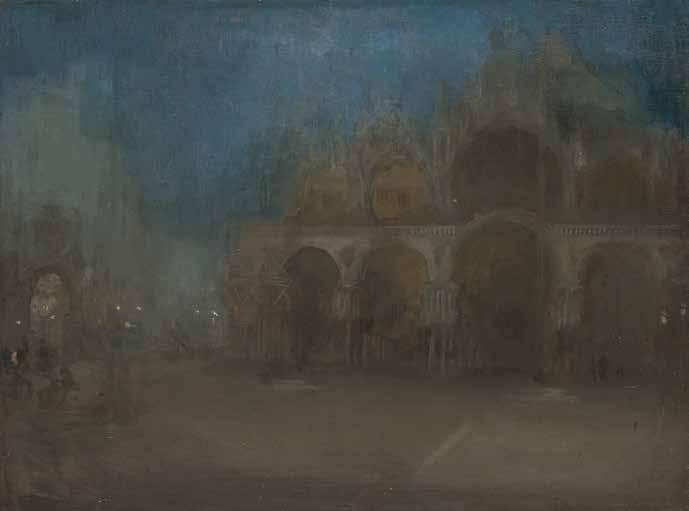
2 minute read
Object in Focus
from Colour Revolution
Nocturne in Blue and Gold: St Mark’s Venice (1880)
by James McNeill Whistler
In February 1883, a new exhibition, Arrangement in White and Yellow, opened at the Fine Art Society on New Bond Street. The title was not simply a reference to the artist’s penchant for musically inclined painting titles: the exhibition rooms were themselves were chromatically arranged. The walls were covered in white fabric and the floors in yellow matting, with yellow tiles for the mantlepiece, yellow moldings and borders, yellow furniture, and yellow vases filled with yellow and white roses. The gallery attendants were dressed in yellow and white livery.340 At the centre of this exhibition full of ‘sentient notes of colour’ was the infamous, James McNeill Whistler, who was exhibiting a series of his Venetian etchings. The press were quick to tackle Whistler, reserving particular vitriol for the enfant-terrible of the Victorian art world. This was a consquence of the scandal his libel case against Ruskin had caused across London society. The art critic had accused Whistler of ‘flinging a pot of paint in the public’s face’ after exhibiting Nocturne in Black and Gold – The Falling Rocket (1872–77) at the Grosvenor Gallery.341 Whistler won, but it was a pyrrhic victory and he was shunned by the cultural elite for airing the grievance in such a public manner. Punch’s reaction to Arrangement in White and Yellow was to publish a satirical poem entitled ‘Whistler in Venice – A Gavotte in Gamboge’, which pilloried the artist’s work as ‘consumedly bilious’.342 A critic from Truth quipped that the exhibition was ‘another crop of Mr. Whistler’s little jokes’. However, full of characteristic ‘American gall’343, Whistler published his critics’ most scathing remarks on the front page of the exhibition catalogue.
In September 1879, in the immediate aftermath of the trial, the Fine Art Society, owned by the publisher William Longman, commissioned Whistler to make a series of 12 etchings in Venice, to help him recover from the bankruptcy caused by the trial and to lay the groundwork for his eventual return to society. Concurrently, perhaps to keep both art-world giants involved with his gallery venture, Longman also set up a subscription fund to help Ruskin recuperate his legal costs.
The etchings and dry points produced after this 14-month exile in Venice have since become crucial in art historical accounts of Whistler’s life and mark a highpoint in his innovative use of the monochrome medium. However, while Whistler recovered and worked in the Lagoon City, he also produced several oil paintings, and returned to the sensorial, subjectless nocturne mode that had originally so offended Ruskin. Whistler embarked on his nocturne series in 1871 with scenes of the Thames at night. The aim of these paintings was, as one critic put it, ‘moulding our moods and stirring our imaginations, by subtle combinations of colour’.344
Six months into his stay he wrote to his friend Matthew Robinson Elden: ‘And mind you, all this while, it is not merely the ‘Views of Venice’ or the ‘Streets of Venice’, or the ‘Canals of Venice’ such as you have seen brought back by the foolish sketcher – but great pictures that stare you in the face – complete arrangements and harmonies in color & form that are ready and waiting for the one who can perceive.’345
Of the three oil paintings that survive from this period, Nocturne in Blue and Gold: St Mark’s Venice (fig. 3.2.2) reminds viewers of Whistler’s





